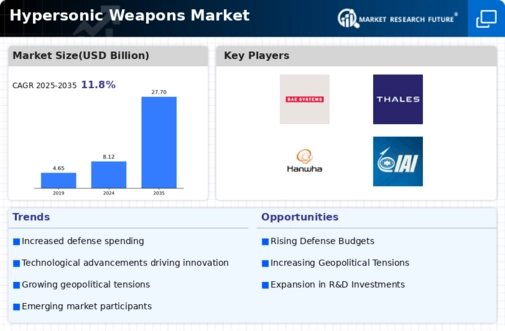Market Analysis
In-depth Analysis of Hypersonic Weapons Market Industry Landscape
The commercial dynamics surrounding hypersonic weapons herald the next phase of speed, accuracy, and strategic potential in warfare. They also represent a fundamental transition. With the ability to travel faster than Mach 5, hypersonic weapons are changing the face of global security and military capabilities. The need for improved deterrent, combined with technological innovation and international geopolitical competitiveness, is driving the market for these fast speeds weapons. The hypersonic weapons industry is mostly being shaped by technological breakthroughs. These cutting-edge vehicles achieve previously unachievable speeds and agility with the assistance of advanced GPS systems, aerodynamic designs, and innovative propulsion technology. Hypersonic weapons are at the forefront of military development since their creation and application necessitate large research and development expenditures. The geopolitical environment and strategic rivalries between countries are major factors influencing the hypersonic weapon market dynamics. The main military nations are racing to develop and use hypersonic capabilities because these missiles can travel great distances quickly and precisely. The ability to deliver nuclear and conventional warheads at speeds faster than those of current defense systems has brought hypersonic guns to the front of tactical planning. Hypersonic weapons are multifunctional weapons that can be used for both attacking and defensive objectives, which has an impact on market dynamics. Hypersonic missiles as well as glide vehicles offer a quick and erratic way to attack targets on the offensive, shortening reaction times and increasing tactical adaptability. In order to confront the growing threat, hypersonic missile defenses have been developed defensively. This is causing a complicated interplay between the market's offensive and defending capabilities. International relationships and collaborations are being fostered by the growth of hypersonic technology. Recognizing the difficulty and expense of achieving hypersonic capabilities, nations collaborate and undertake cooperative research projects. Collaborations reflect the global aspect of the technical race in this industry by aiming to exchange experience, pool resources, and speed up the creation of hypersonic weapons. The marketplace patterns for hypersonic weapons are drastically impacted by changes in defense spending and budgetary considerations. Countries invest significant funds in R&D and deployment initiatives for these cutting-edge technologies, indicating the strategic value that is placed on hypersonic capabilities. The amount of money nations invest in developing hypersonic weapons is influenced by a number of variables, including budgetary constraints, geopolitical unrest, and economic considerations. In order to confront the growing threat, hypersonic missile defenses have been developed defensively. This is causing a complicated interplay between the market's offensive and defending capabilities. The changing threat picture is another factor contributing to the hypersonic weapons market's dynamic nature. Current missile defense systems face difficulties from hypersonic missiles' speed and unpredictable nature, which has refocused attention on defense tactics and countermeasures. The market's constantly changing and competitive nature is a result of this ongoing adaptation and reaction to new threats. The market trends regarding hypersonic weapons are further influenced by export potential and international arms sales. Nations with sophisticated hypersonic capabilities might look into selling these technologies to other allies looking to improve their military prowess. Potential cross-border partnerships in hypersonic technology establish a worldwide marketplace in which countries exchange and vie for access to state-of-the-art capabilities. The dynamics of the hypersonic weapon market, in summary, signify a paradigm change in military equipment and strategic thought. The market for hypersonic weapons is competitive and dynamic, shaped by geopolitical rivalries, technological innovation, and the changing threat scenario. The development and use of hypersonic weapons is going to keep influencing the worldwide strategic balance as states compete to demonstrate their military superiority and tackle new security issues.

















Leave a Comment